For the 2025 school year, there are 2 public elementary schools serving 1,106 students in Dillon 03 School District. This district's average elementary testing ranking is 7/10, which is in the top 50% of public elementary schools in South Carolina.
Public Elementary Schools in Dillon 03 School District have an average math proficiency score of 40% (versus the South Carolina public elementary school average of 39%), and reading proficiency score of 46% (versus the 47% statewide average).
Minority enrollment is 51% of the student body (majority Black), which is less than the South Carolina public elementary school average of 53% (majority Black).
Overview
This School District
This State (SC)
# Schools
3 Schools
965 Schools
# Students
1,512 Students
551,243 Students
# Teachers
89 Teachers
39,892 Teachers
Student : Teacher Ratio
17:1
17:1
District Rank
Dillon 03 School District, which is ranked within the top 50% of all 76 school districts in South Carolina (based off of combined math and reading proficiency testing data) for the 2021-2022 school year.
The school district's graduation rate of 75-79% has decreased from 80-84% over five school years.
Overall District Rank
#27 out of 81 school districts
(Top 50%)
(Top 50%)
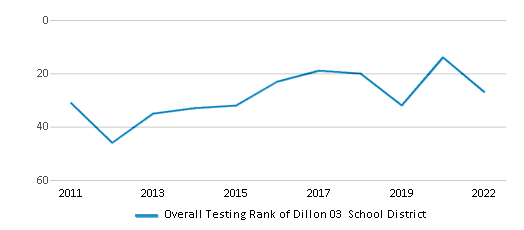
Math Test Scores (% Proficient)
40%
41%
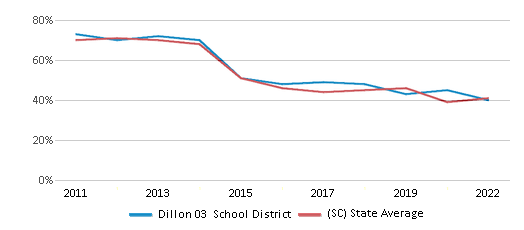
Reading/Language Arts Test Scores (% Proficient)
51%
52%
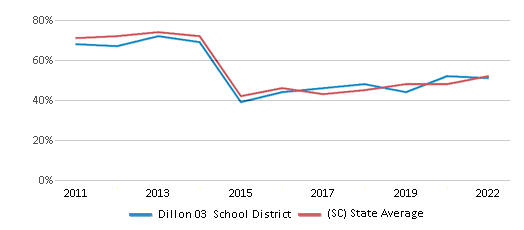
Science Test Scores (% Proficient)
48%
50%
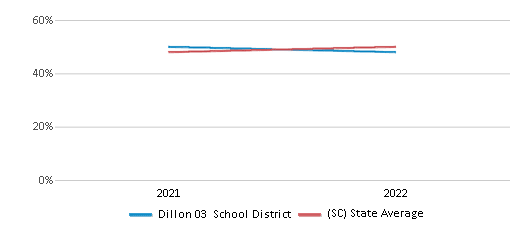
Graduation Rate
75-79%
84%

Students by Ethnicity:
Diversity Score
0.61
0.67
# American Indian Students
21 Students
1,609 Students
% American Indian Students
2%
n/a
# Asian Students
4 Students
10,166 Students
% Asian Students
n/a
2%
# Hispanic Students
74 Students
74,117 Students
% Hispanic Students
5%
13%
# Black Students
541 Students
170,518 Students
% Black Students
36%
31%
# White Students
775 Students
258,372 Students
% White Students
51%
47%
# Hawaiian Students
1 Student
663 Students
% Hawaiian Students
n/a
n/a
# Two or more races Students
96 Students
35,675 Students
% of Two or more races Students
6%
7%
Students by Grade:
# Students in PK Grade:
82
24,436
# Students in K Grade:
109
53,057
# Students in 1st Grade:
125
56,847
# Students in 2nd Grade:
91
58,232
# Students in 3rd Grade:
117
57,411
# Students in 4th Grade:
112
57,861
# Students in 5th Grade:
115
58,020
# Students in 6th Grade:
117
58,906
# Students in 7th Grade:
122
54,750
# Students in 8th Grade:
116
55,491
# Students in 9th Grade:
138
4,594
# Students in 10th Grade:
88
4,219
# Students in 11th Grade:
96
3,860
# Students in 12th Grade:
84
3,559
# Ungraded Students:
-
-
District Revenue and Spending
The revenue/student of $11,515 in this school district is less than the state median of $15,220. The school district revenue/student has stayed relatively flat over four school years.
The school district's spending/student of $11,317 is less than the state median of $14,817. The school district spending/student has stayed relatively flat over four school years.
Total Revenue
$17 MM
$12,084 MM
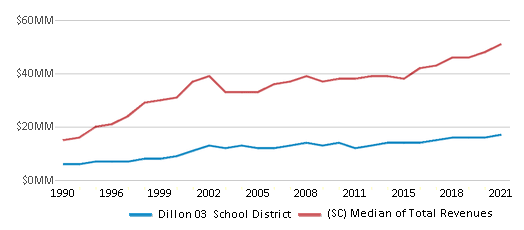
Spending
$17 MM
$11,764 MM

Revenue / Student
$11,515
$15,220
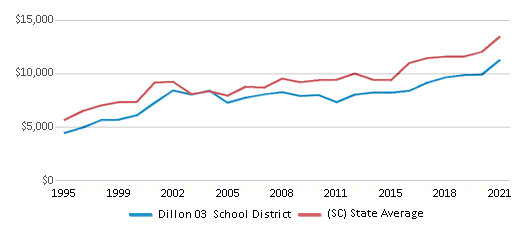
Spending / Student
$11,317
$14,817
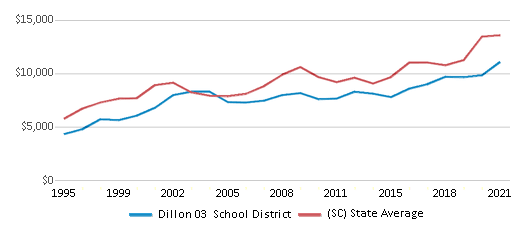
Best Dillon 03 School District Public Elementary Schools (2025)
School
(Math and Reading Proficiency)
(Math and Reading Proficiency)
Location
Grades
Students
Rank: #11.
Latta Elementary School
(Math: 42% | Reading: 45%)
Rank:
Rank:
5/
Bottom 50%10
300 Viking Drive
Latta, SC 29565
(843) 752-5295
Latta, SC 29565
(843) 752-5295
Grades: PK-4
| 636 students
Rank: #22.
Latta Middle School
(Math: 39% | Reading: 46%)
Rank:
Rank:
5/
Bottom 50%10
612 North Richardson Street
Latta, SC 29565
(843) 752-7117
Latta, SC 29565
(843) 752-7117
Grades: 5-8
| 470 students
Recent Articles

Year-Round Or Traditional Schedule?
Which is more appropriate for your child? A year-round attendance schedule or traditional schedule? We look at the pros and cons.

Why You Should Encourage Your Child to Join a Sports Team
Participating in team sports has a great many benefits for children, there is no doubt. In this article you will learn what those benefits are.

White Students are Now the Minority in U.S. Public Schools
Increasing birth rates among immigrant families from Asia and Central and South America, combined with lower birth rates among white families, means that for the first time in history, public school students in the United States are majority-minority. This shift in demographics poses difficulties for schools as they work to accommodate children of varying language abilities and socio-economic backgrounds.





